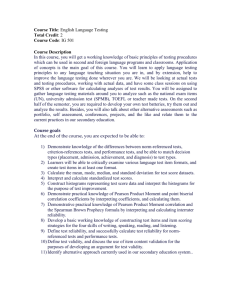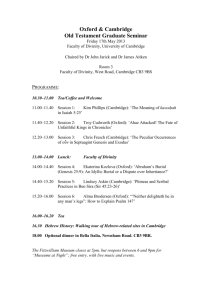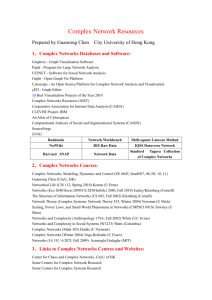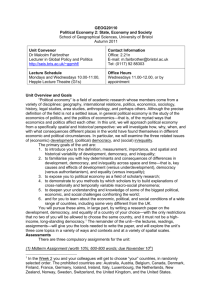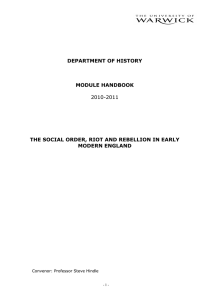Department of Economics John Weymark Vanderbilt University
advertisement
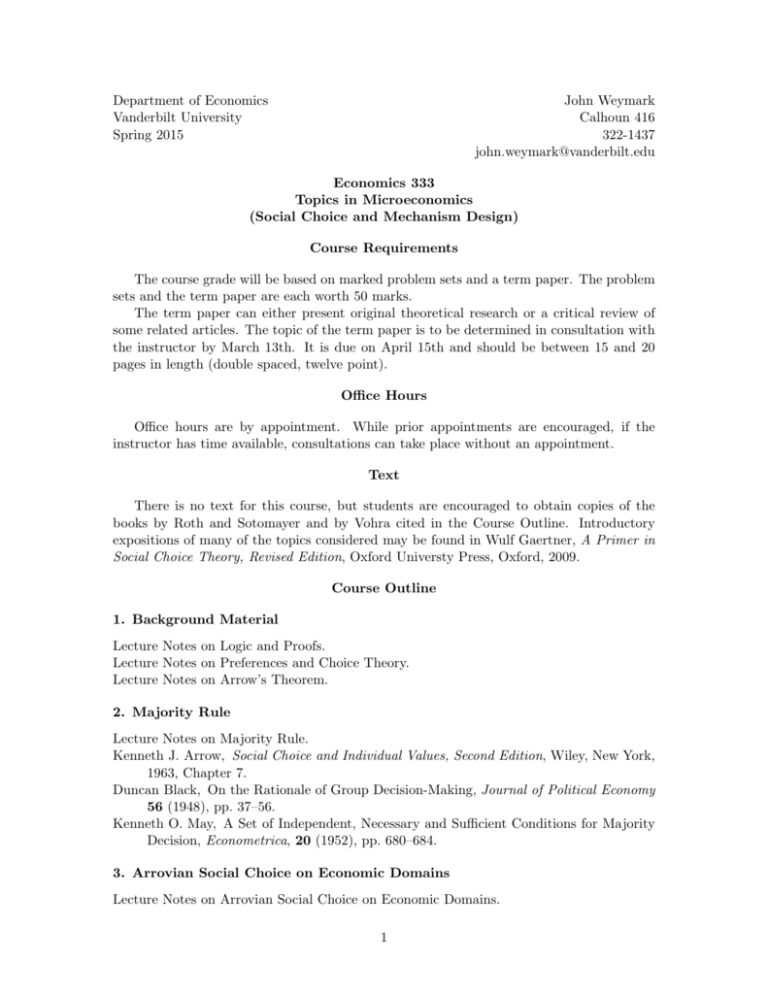
Department of Economics Vanderbilt University Spring 2015 John Weymark Calhoun 416 322-1437 john.weymark@vanderbilt.edu Economics 333 Topics in Microeconomics (Social Choice and Mechanism Design) Course Requirements The course grade will be based on marked problem sets and a term paper. The problem sets and the term paper are each worth 50 marks. The term paper can either present original theoretical research or a critical review of some related articles. The topic of the term paper is to be determined in consultation with the instructor by March 13th. It is due on April 15th and should be between 15 and 20 pages in length (double spaced, twelve point). Office Hours Office hours are by appointment. While prior appointments are encouraged, if the instructor has time available, consultations can take place without an appointment. Text There is no text for this course, but students are encouraged to obtain copies of the books by Roth and Sotomayer and by Vohra cited in the Course Outline. Introductory expositions of many of the topics considered may be found in Wulf Gaertner, A Primer in Social Choice Theory, Revised Edition, Oxford Universty Press, Oxford, 2009. Course Outline 1. Background Material Lecture Notes on Logic and Proofs. Lecture Notes on Preferences and Choice Theory. Lecture Notes on Arrow’s Theorem. 2. Majority Rule Lecture Notes on Majority Rule. Kenneth J. Arrow, Social Choice and Individual Values, Second Edition, Wiley, New York, 1963, Chapter 7. Duncan Black, On the Rationale of Group Decision-Making, Journal of Political Economy 56 (1948), pp. 37–56. Kenneth O. May, A Set of Independent, Necessary and Sufficient Conditions for Majority Decision, Econometrica, 20 (1952), pp. 680–684. 3. Arrovian Social Choice on Economic Domains Lecture Notes on Arrovian Social Choice on Economic Domains. 1 Ehud Kalai, Eitan Muller, and Mark A. Satterthwaite, Social Welfare Functions when Preferences are Convex, Strictly Monotonic, and Continuous, Public Choice 34 (1979), 87–97. Michel Le Breton and John A. Weymark, Arrovian Social Choice Theory on Economic Domains, in Kenneth J. Arrow, Amartya K. Sen, and Kotaro Suzumura, eds., Handbook of Social Choice and Welfare, Volume 2, North-Holland, Amsterdam, 2011, pp. 191– 299. 4. Social Choice with Interpersonal Utility Comparisons Lecture Notes on Social Welfare Functionals. Charles Blackorby, David Donaldson, and John A. Weymark, Social Choice with Interpersonal Utility Comparisons: A Diagrammatic Introduction, International Economic Review 25 (1984), pp. 327–356. Walter Bossert and John A. Weymark, Utility in Social Choice, in Salvador Barberà, Peter J. Hammond, and Christian Seidl, eds., Handbook of Utility Theory. Volume 2: Extensions, Kluwer Academic Publishers, Boston, 2004, pp. 1099–1177. 5. Uncertainty and Social Choice John C. Harsanyi, Cardinal Utility, Individualist Ethics, and Interpersonal Comparisons of Utility, Journal of Political Economy 63 (1955), pp. 309–321. Philippe Mongin and Marcus Pivato, Social Preference and Social Welfare Under Risk and Uncertainty, in Matthew D. Adler and Marc Fleurbaey, eds., The Oxford Handbook of Well-Being and Public Policy, Oxford University Press, Oxford, 2015, forthcoming. John A. Weymark, Harsanyi’s Social Aggregation Theorem with Alternative Pareto Principles, in Wolfgang Eichhorn, ed., Models and Measurement of Welfare and Inequality, Springer-Verlag, Berlin, 1994, pp. 869–887. John A. Weymark, A Reconsideration of the Harsanyi–Sen Debate on Utilitarianism, in Jon Elster and John E. Roemer, eds., Interpersonal Comparisons of Well-Being, Cambridge University Press, Cambridge, 1991, pp. 255–320. John A. Weymark, Measurement Theory and the Foundations of Utilitarianism, Social Choice and Welfare 25 (2005), pp. 527–555. 6. Power and Collective Rationality David Austen-Smith and Jeffrey S. Banks, Positive Political Theory I: Collective Preference, University of Michigan Press, Ann Arbor, 1999, Chapter 2. Allan F. Gibbard, Intransitive Indifference and the Arrow Dilemma, Review of Economic Design 18 (2004), 3–10 (originally written in 1969–70). Bengt Hansson, The Existence of Group Preference Functions, Public Choice 28 (1976), 89–98. 7. Judgment Aggregation Davide Grossi and Gabriella Pigozzi, Judgment Aggregation: A Primer, Morgan & Claypool Publishers, San Rafael, CA, 2014, Chapters 1–3. Christian List, The Theory of Judgment Aggregation: An Introductory Review, Synthese 187 (2012), pp. 179–207. 2 Christian List and Philip Pettit, Aggregating Sets of Judgments: An Impossibility Result, Economics and Philosophy 18 (2002), pp. 89–110. Philippe Mongin, The Doctrinal Paradox, the Discursive Dilemma, and Logical Aggregation Theory, Theory and Decision 73 (2012), pp. 315–335. 8. Matching and Market Design Lecture Notes on One-to-One Two-Sided Matching. Donald E. Campbell, Incentives: Motivation and the Economics of Information, Second Edition, Cambridge University Press, Cambridge, 2006, Chapter 9. David Gale and Lloyd S. Shapley, College Admissions and the Stability of Marriage, American Mathematical Monthly 69 (1962), pp. 9–15. Debasis Mishra, Theory of Mechanism Design, unpublished lecture notes, Indian Statistical Center, New Delhi, 2014, Sections 2.4–2.6. Alvin Roth and Marilda Sotomayer, Two-Sided Matching: A Study in Game-Theoretic Modeling and Analysis, Cambridge University Press, Cambridge, 1990, Chapters 1–3. Tayfun Sönmez and M. Utku Ünver, Matching, Allocation, and Exchange of Discrete Resources, in Jess Benhabib, Alberto Bisin, and Matthew O. Jackson, eds., Handbook of Social Economics, Volume 1A, North-Holland, Amsterdam, 2011, pp. 781–852. 9. Mechanism Design with Transfers Katherine Cuff, Sunghoon Hong, Jesse A. Schwartz, Quan Wen, and John A. Weymark, Dominant Strategy Implementation with a Convex Product Set of Valuations, Social Choice and Welfare 39 (2012), pp. 567–597. Debasis Mishra, Theory of Mechanism Design, unpublished lecture notes, Indian Statistical Center, New Delhi, 2014, Chapter 3. Rakesh V. Vohra, Mechanism Design: A Linear Programming Approach, Cambridge University Press, Cambridge, 2011, Section 2.3 and Chapters 3–5. 3

